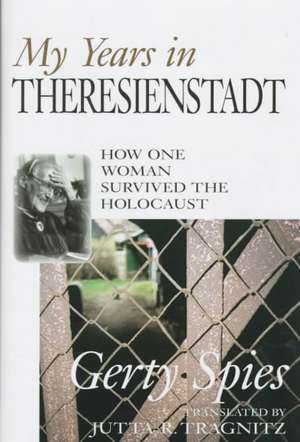My Years in Theresienstadt: How One Woman Survived the Holocaust
Autor Gerty Spies Traducere de Jutta R. Tragnitzen Limba Engleză Hardback – 30 apr 1997
Gerty Spies was born in 1897 at Trier into a Jewish family whose ancestors had lived in Germany for centuries. Separated from her family by the Nazis, she was sent to the Czech camp known as Theresienstadt. It was a peculiar place: publicized as a retirement city, a Nazi propaganda showplace where Jews could sit out the war. But it was actually a way station for those destined for the Auschwitz death camp. Isolated from the outside world, surrounded by death, Spies retreated to her inner self to concentrate on human, cultural, and other values. Her powerful talent for writing, discovered at the camp; enabled her to transcend and triumph over mental and physical degradations; to keep her own integrity; to not let evil destroy her loving nature; and, finally, to not lose faith in humanity. By the end of the war, 33,000 people died in Theresienstadt from disease and malnutrition. Spies' work exhibits a tension between the expression of camp reality and an imagination of an idealized past. Sensitive and humorous, but never bitter, her stories of the struggle for survival are expressions of her own individual moral poise.
Preț: 217.77 lei
Nou
Puncte Express: 327
Preț estimativ în valută:
41.67€ • 43.65$ • 34.54£
41.67€ • 43.65$ • 34.54£
Carte disponibilă
Livrare economică 18 martie-01 aprilie
Preluare comenzi: 021 569.72.76
Specificații
ISBN-13: 9781573921411
ISBN-10: 1573921416
Pagini: 214
Ilustrații: b/w photos
Dimensiuni: 160 x 237 x 22 mm
Greutate: 0.49 kg
Editura: Prometheus Books
ISBN-10: 1573921416
Pagini: 214
Ilustrații: b/w photos
Dimensiuni: 160 x 237 x 22 mm
Greutate: 0.49 kg
Editura: Prometheus Books
Notă biografică
Gerty Spies, (Munich, Germany) 98, is the author of Das schwarze Kleid (The Black Garment). She has received awards promoting ongoing dialogue between Jews and non-Jews, and has served as honorary chairperson for the Society for Christian-Jewish Cooperation. Jutta R. Tragnitz is a doctoral candidate in the German Department of the University of Illinois at Chicago.
Textul de pe ultima copertă
Theresienstadt, located in Czechoslovakia, was a peculiar concentration camp. It was publicized as a retirement city, a place for privileged and prominent Jews to sit out the war. In reality, it was a collection point, a Schleuse or "sluice", for arriving and departing transports, most of them destined for Auschwitz. Prisoners suffered from disease, starvation, exhaustion, overcrowding, and the persistent threat of deportation. Between 1941 and 1945, about 33,000 people died in Theresienstadt of disease and malnutrition, while about 88,000 were transported to the death camps in the East. The desperate need for self-preservation caused by the isolation and deprivations of camp life mobilized prisoners to cope in their own special ways. Some placed their emphasis on nourishment, others developed asocial traits of behavior, while others retained their cultural interests. These creative activities helped artists as well as amateurs block out the fear and uncertainty while helping to restore the dignity otherwise denied them. From this maelstrom of inhumanity, Gerty Spies found her salvation in writing. Isolated from the outside world and surrounded by death, she retreated into her inner self to concentrate on human, cultural, and spiritual values. Her ability to transcend and triumph over mental and physical degradations, to keep her own integrity, to defeat the evil that tried to destroy her loving nature, and to maintain her faith in human beings gives Gerty Spies's narrative extraordinary power. Throughout her ordeal, Spies displays an unwavering belief in the decency, goodness, and sincerity of all people. No trace of cynicism, malice, or enmity finds a place in her life or work. Despite living for three years surrounded by horror, Gerty Spies's loving and kind disposition enabled her "to forgive - but not to forget". Returning to Germany after the war, Spies reconciled her experiences under the Nazi regime with a new, full life as an artist among newfound friends. She has devoted her life to keeping open the dialogue of understanding between people, a philosophy of life so often expressed in her personal motto, Vestehen und Lieben ... to understand and to love.
